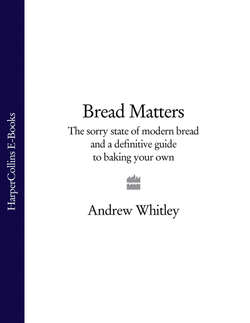Читать книгу Bread Matters: The sorry state of modern bread and a definitive guide to baking your own - Andrew Whitley - Страница 36
Time to choose
ОглавлениеBritish bread is a nutritional, culinary, social and environmental mess – made from aggressively hybridised wheat that is grown in soils of diminishing natural fertility, sprayed with toxins to counter pests and diseases, milled in a way that robs it of the best part of its nutrients, fortified with just two minerals and two vitamins in a vain attempt to make good the damage, and made into bread using a cocktail of functional additives and a super-fast fermentation (based on greatly increased amounts of yeast), which inhibits assimilation of some of the remaining nutrients while causing digestive discomfort to many consumers.
There are some signs of a renaissance of small-scale artisan baking. However, the whole ‘craft’ bakery sector accounts for only 6 per cent of UK bread so, unless something changes, most people will have to put up with bread from the industrial plant bakers or the supermarket in-store bakeries for a long time to come, perhaps for ever.
The concentration of commercial power into ever bigger corporate units is often presented as being necessary to keep prices down and enlarge consumer choice. And on the face of it, the consumer has never been offered so many choices before. Scores of brands and hundreds of ranges compete for shelf space and seem to cater for every conceivable preference. But are these real choices?
The world’s seeds and plant breeding programmes are dominated by a handful of global corporations, as is the trade in key food commodities. Four supermarket chains account for the majority of retail sales in the UK. Yes, these companies compete against one another. But they do so from within a single monolithic view of how the world should feed itself. Standardisation in the name of ‘efficiency’ and cost reduction has led to increasing dependence on just a few varieties of key crops and methods of processing. Over 80 per cent of British bread is made by the ultra-fast, additive-dependent Chorleywood Bread Process. Much of the rest, particularly in the supermarkets’ in-store bakeries, uses a similar range of chemical and enzyme additives in the process known as activated dough development. For most consumers, ‘choice’ between breads is meaningless because they are all made in essentially the same way.
Meanwhile, advertising keeps alive the illusion of choice. It emphasises minor differences between brands or varieties and keeps very quiet indeed about what really goes into, or is left out of, our daily bread.
Not surprisingly, disappointment with the bland character of overprocessed food is fuelling a growing outrage at the food industry’s lack of transparency and cynical exploitation of farmers, process workers and consumers. People are realising that the undoubted convenience of processed food comes at the expense of any sense of control over our most basic nourishment. If the food industry won’t tell us what is really in our food, how can we make sensible choices, let alone feel that we are doing the right thing for the health of ourselves and our families?
It is time to take matters into our own hands. One way of fighting back is to refuse to buy foods produced in ways we find unacceptable. Making bread at home enables us to take control of a significant part of our diet by choosing exactly what goes into it. But if this control is to be real, we must first define what wholesome, nutritious and digestible bread really is. Simply to imitate commercial loaves is to accept the industrial food agenda.
My aim is to show that making good bread is not difficult.
